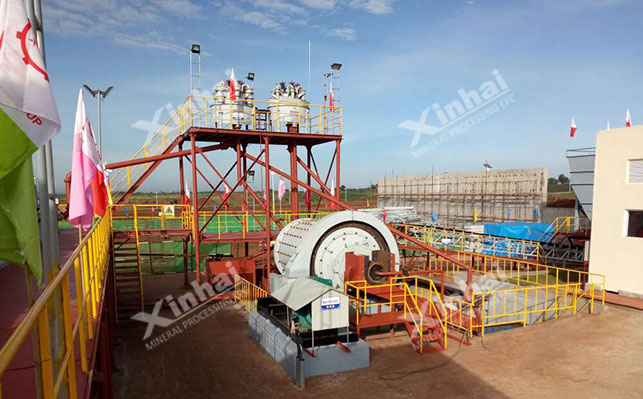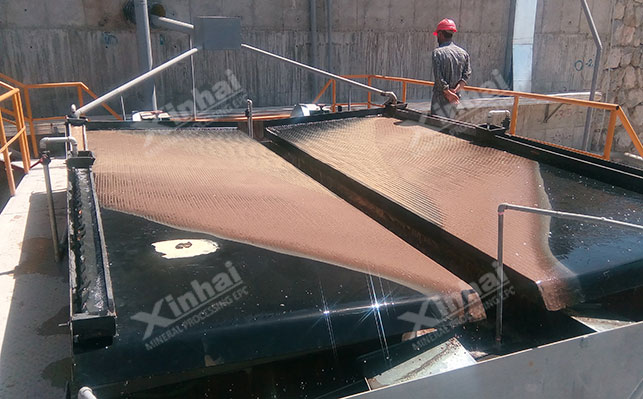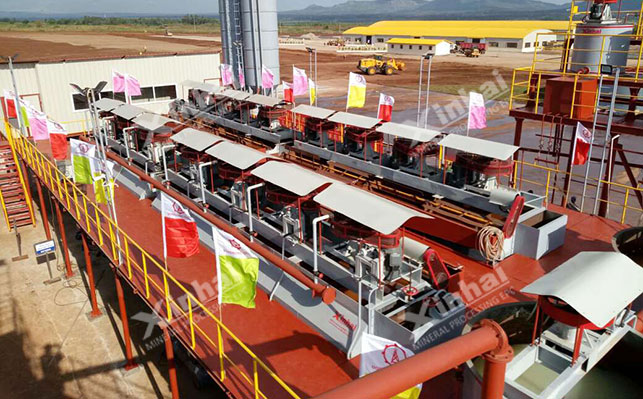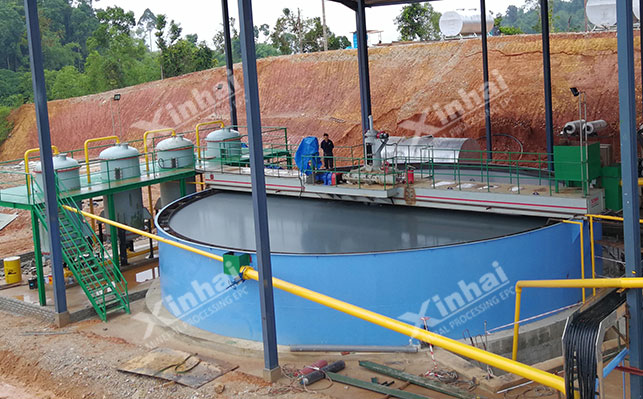
15311826613
Click to add WeChatGold ore beneficiation is a series of processes to extract gold from gold ore and enrich it. Due to the complex and diverse properties of gold ore, the beneficiation process needs to be carefully designed according to the characteristics of the ore to achieve efficient gold recovery and resource utilization. It covers multiple key links, each of which plays a vital role in the final beneficiation effect. The specific beneficiation process includes: crushing, grinding classification, sorting and dehydration.
The crushing process of gold ore needs to be determined according to the properties of the gold ore and the required sorting particle size requirements, usually including coarse crushing, medium crushing and fine crushing.

Coarse crushing: The purpose is to initially crush large pieces of raw ore to smaller particle size for subsequent further processing, and at the same time, some gangue minerals that coexist with gold begin to dissociate. The jaw crusher is usually used to complete the operation. The large gold ore mined is sent into the jaw crusher. The eccentric shaft is driven by the motor to make the movable jaw plate swing back and forth periodically, approaching or leaving the fixed jaw plate, squeezing and splitting the ore sandwiched between them to achieve crushing.
Medium crushing: The function is to further reduce the particle size of the ore, provide more suitable feed for subsequent fine crushing and grinding, and continue to promote the dissociation of gold and gangue minerals. The cone crusher is usually used to complete the operation. The coarsely crushed ore enters the cone crusher, fixed by the outer cone, and the inner cone is driven by the eccentric shaft sleeve to make an eccentric rotation, so that the ore is squeezed, bent and impacted between the inner and outer cones and crushed.
Fine crushing: The purpose is to crush the ore to a finer particle size, meet the strict requirements of the grinding operation on the feed particle size, fully dissociate the gold minerals and gangue, and create good conditions for subsequent selection. The impact crusher is usually used to complete the operation. The process is that the ore after medium crushing enters the impact crusher, and the plate hammer is driven by the high-speed rotating rotor to throw the ore to the impact plate. The ore repeatedly collides and rebounds between the plate hammer and the impact plate until it is crushed into a qualified particle size and discharged from the discharge port.
The gold ore grinding link is the process of continuing to grind the ore after crushing. The main purpose is to grind the fine ore to a selectable particle size condition (that is, to achieve the monomer dissociation state between gold and other minerals). The process of gold ore grinding usually includes coarse grinding and fine grinding stages.

Coarse grinding: rod mill is generally used. First, the gold ore that has been initially crushed in the crushing link is added to the cylinder of the rod mill together with an appropriate amount of water and steel rods. The motor drives the cylinder to rotate. Under the action of centrifugal force and friction, the steel rod is lifted to a certain height and then falls, impacting and grinding the ore to further reduce the ore particle size. The steel rods of the rod mill grind the ore in a line contact manner. Compared with the ball mill, it can effectively reduce the phenomenon of over-crushing and produce products with uniform particle size. Through coarse grinding, the gold ore is ground to a suitable particle size range, and the gold minerals and gangue minerals are initially separated, providing suitable raw materials for subsequent fine grinding and classification operations.
Fine grinding: The slurry after coarse grinding enters the ball mill for fine grinding. The ball mill cylinder is equipped with steel balls of different specifications. The motor drives the cylinder to rotate. The steel balls rise to a certain height with the cylinder and then fall down, impacting and grinding the ore, so that the ore is ground to a finer particle size that meets the selection requirements. The ball mill has strong adaptability and can handle gold ores of various hardness and properties. By adjusting the parameters such as the type, ratio and filling rate of the grinding medium, it can adapt to different grinding needs. In the fine grinding process, the degree of separation of gold minerals and gangue minerals is further improved to ensure that gold can be efficiently recovered in subsequent selection operations.
Classification: Classification is crucial in the grinding process. Common classification equipment includes spiral classifiers and hydrocyclones. When the spiral classifier is working, the ore pulp after grinding flows into it, and the spiral blades rotate slowly under the drive of the reducer. The coarse-grained minerals move to the high weir end under the force of gravity and the spiral blades, and are discharged from the overflow port and returned to the grinding operation for re-grinding; the fine-grained minerals are discharged from the bottom of the tank with the ore pulp and sent to the subsequent separation operation as qualified products. The working principle of the hydrocyclone is that the ore pulp enters from the tangential direction with a certain pressure. Under the centrifugal force generated by high-speed rotation, the coarse-grained minerals are thrown to the wall of the device and move downward along the wall, and are discharged from the bottom flow port and returned to the grinding; the fine-grained minerals are discharged from the overflow port with the ore pulp in the center and enter the separation link. The classification operation can accurately control the particle size of the grinding product, ensure that the particle size of the material entering the subsequent separation operation meets the requirements, and improve the separation efficiency and concentrate quality.
Gold ore selection is the key link to separate and enrich gold minerals from gold ore. Its process mainly includes gravity separation, flotation, cyanidation, etc.
Gravity separation: It is divided into jigging gravity separation and shaking table gravity separation. Among them, jigging gravity separation uses jig equipment. The slurry flows into the jig chamber of the jig machine, and the diaphragm reciprocates up and down, allowing the water to form an up and down alternating water flow in the chamber. Under this action, the mineral particles are layered according to density, and the dense gold minerals and heavy minerals settle to the lower layer, and the light minerals remain in the upper layer and are then discharged separately. This gravity separation is mostly suitable for roughing operations. Shaking table gravity separation is that the slurry is fed to the inclined shaking table bed, and the horizontal water flow flows evenly from one side. The longitudinal asymmetric reciprocating motion of the bed surface and the horizontal water flow work together to divide the mineral particles into zones on the bed surface according to density and particle size. The dense gold minerals are concentrated in the concentrate zone of the bed surface, and the light minerals are distributed in the tailings zone. This gravity separation is suitable for fine selection operations

Flotation method: After grinding and classification, the pulp enters the flotation machine, and flotation agents need to be added, including collectors, frothers, and regulators. The collector is adsorbed on the surface of the gold mineral to make it hydrophobic; the frother produces a large number of bubbles in the pulp; the regulator adjusts the pH of the pulp and other mineral surface properties. Under the action of stirring, the gold mineral adheres to the bubbles and floats to the surface of the pulp with the bubbles to form a foam layer. The flotation concentrate is obtained by scraping off the foam layer.

Cyanidation method: First, cyanide leaching is stirred to form a soluble gold-cyanide complex into the solution, and then zinc powder replacement or desorption electrolysis is performed to obtain gold. The process is to add cyanide solution to the pulp in the leaching tank and stir it to allow gold to react chemically with cyanide to form a soluble gold-cyanide complex that enters the solution. Then the leached gold-containing solution flows into the displacement tank, and zinc powder is added to displace the gold ions in the solution to generate metallic gold precipitation and obtain gold mud. After subsequent smelting and purification, finished gold can be obtained, or desorption electrolysis can be used to extract gold.

The main reason for gold mine dehydration is that the gold concentrate and tailings obtained after selection contain a certain amount of water, which affects the subsequent smelting and storage, and needs to be dehydrated. Generally, the dehydration of gold concentrate is completed by concentrators and filters; the dehydration of gold tailings depends on the final water content requirements. The process is usually to first feed the slurry into the concentrator for slow sedimentation, and the solid particles gradually settle to the bottom of the concentrator and are scraped out, and then fed into the filter press. Under the action of pressure, the water is squeezed out through the filter cloth, and the solid particles are trapped in the filter chamber to form a filter cake. When the filter cake forms a certain thickness, it is unloaded by pulling open the filter plate.
Each link in the gold ore beneficiation process is closely linked. By rationally selecting and configuring equipment and optimizing process parameters, the gold recovery rate and concentrate quality can be effectively improved, thus achieving efficient development and utilization of gold ore resources.